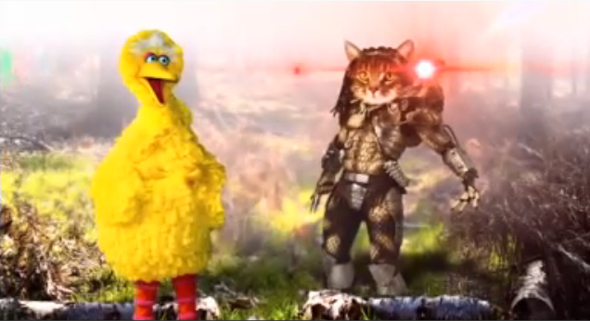It’s always good to see the Humane Society of the United States supporting and promoting TNR. After all, it wasn’t all that long ago when HSUS was on the other side of the issue. In 1997, when the American Bird Conservancy launched its Cats Indoors! campaign, the organization was “singled out as its ‘principal partner in this endeavor.’” [1]
On Monday, President and CEO Wayne Pacelle, waded into the feral cat/wildlife debate on his blog (brought to my attention by a helpful reader), noting that HSUS “work[s] for the protection of both feral cats and wildlife.”
HSUS is, says Pacelle, “working to find innovative, effective, and lasting solutions to this conflict.” In Hawaii, for example (“an ideal environment for free-roaming cats and a global hotspot for threatened and endangered wildlife”) HSUS is “meeting with local humane societies, state and federal wildlife officials, non-governmental organizations, and university staff to find solutions to humanely manage outdoor cat populations and ensure the protection of Hawaii’s unique wildlife.” (HSUS may want to add Hawaii’s various Invasive Species Committees to that list. If recent efforts are any indication, they’re contributing to the environment impact.)
I can certainly understand HSUS’s current focus on Hawaii, and I look forward to seeing the results of their efforts. It’s not difficult to imagine such results being adopted more broadly. (Tackle the really tough job first, and the others will be easy by comparison, right?)
Still, it’s important to remember that TNR opponents aren’t limiting their attention to such hotspots.
Beyond Hawaii
The Wildlife Society, for example, in its position statement (issued in August) on Feral and Free-Ranging Domestic Cats (PDF), calls for “the humane elimination of feral cat populations,” as well as “the passage and enforcement of local and state ordinances prohibiting the feeding of feral cats.”
Earlier this month, TWS hosted the U.S. Fish and Wildlife Service’s workshop, Influencing Local Scale Feral Cat Trap-Neuter-Release Decisions, at its annual conference.
And in October, ABC sent a letter to mayors of the 50 largest cities in the country “urg[ing them] to oppose Trap-Neuter-Re-abandon (TNR) programs and the outdoor feeding of cats as a feral cat management option.” (This, ABC claims, will “stop spread of feral cats.” I e-mailed Darin Schroeder, ABC’s Vice President for Conservation Advocacy, asking that he explain the biology and/or logic behind this miracle cure, but he never replied.)
Common Ground(?)
But we’re all after the same thing, right—no more “homeless” cats? The key difference being how we approach the problem?
I used to think so. Now, I’m not so sure.
TWS, ABC, and other TNR opponents are calling for the extermination—on the order of tens of millions—of this country’s most popular pet. Without, it must be recognized, a plan of any kind, or, given our decades of experience with lethal control methods, any hope of success. Nevertheless, they persist—grossly misrepresenting the impacts of cats on wildlife and public health in order to drum up support.
Common ground has proven remarkably elusive, and collaboration risky.
In the Spring issue of The Wildlife Professional (published by TWS) Nico Dauphine portrayed the New Jersey Audubon Society as sellouts for participating in the New Jersey Feral Cat & Wildlife Coalition (which included several supporters of TNR, including HSUS), a collaborative effort funded by the Regina R. Frankenberg and Geraldine R. Dodge foundations. [2, 3] The group’s commendable work, culminating in a pilot program based on their “ordinance and protocols for the management of feral cat colonies in wildlife-sensitive areas in Burlington County, New Jersey,” [4] (available here) has, from what I can tell, received little attention.
All of which suggests that we’re actually talking not only about very different means, but also very different ends.
• • •
How does one find common ground in the midst of a witch-hunt?
Earlier this month, Alley Cat Allies co-founder and president Becky Robinson proposed a crucial first step: “stop pitting species against species.”
“Today, I call on the leaders of the American Bird Conservancy, The Wildlife Society, and the leadership of the U.S. Fish and Wildlife Service, who persist in using flawed science and vicious rhetoric like Dauphine’s to blame cats for species decline, to stop.”
After which, there’s plenty of “real work” (some of which may, ironically, prove rather straightforward and uncontroversial) to be done, of course. Still, perhaps the situation in Hawaii is urgent enough, and the stakes high enough, to focus the mind—to get us that far.
Literature Cited
1. Berkeley, E.P., TNR Past present and future: A history of the trap-neuter-return movement. 2004, Bethesda, MD: Alley Cat Allies.
2. Dauphine, N., “Follow the Money: The Economics of TNR Advocacy.” The Wildlife Professional. 2011. 5(1): p. 54.
3. Stiles, E., NJAS Works with Coalition to Reduce Bird Mortality from Outdoor Cats. 2008, New Jersey Audubon Society. http://www.njaudubon.org/Portals/10/Conservation/PDF/ConsReportSpring08.pdf
4. n.a., Pilot Program: Ordinance & Protocols for the Management of Feral Cat Colonies in Wildlife-Sensitive Areas in Burlington County, New Jersey. 2007, New Jersey Feral Cat & Wildlife Coalition. p. 17. http://www.neighborhoodcats.org/uploads/File/Resources/Ordinances/NJ%20FeralCat&Wildlife%20Ordinance&Protocols_Pilot_7_07.doc


